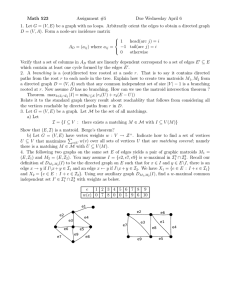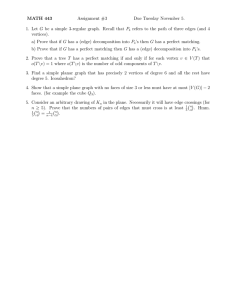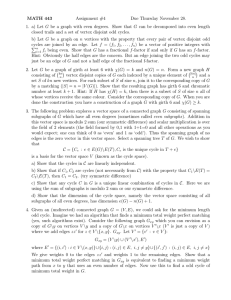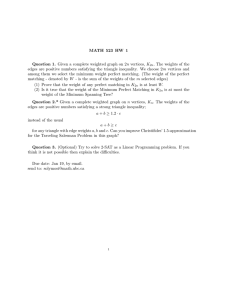Course 18.312: Algebraic Combinatorics 1
advertisement
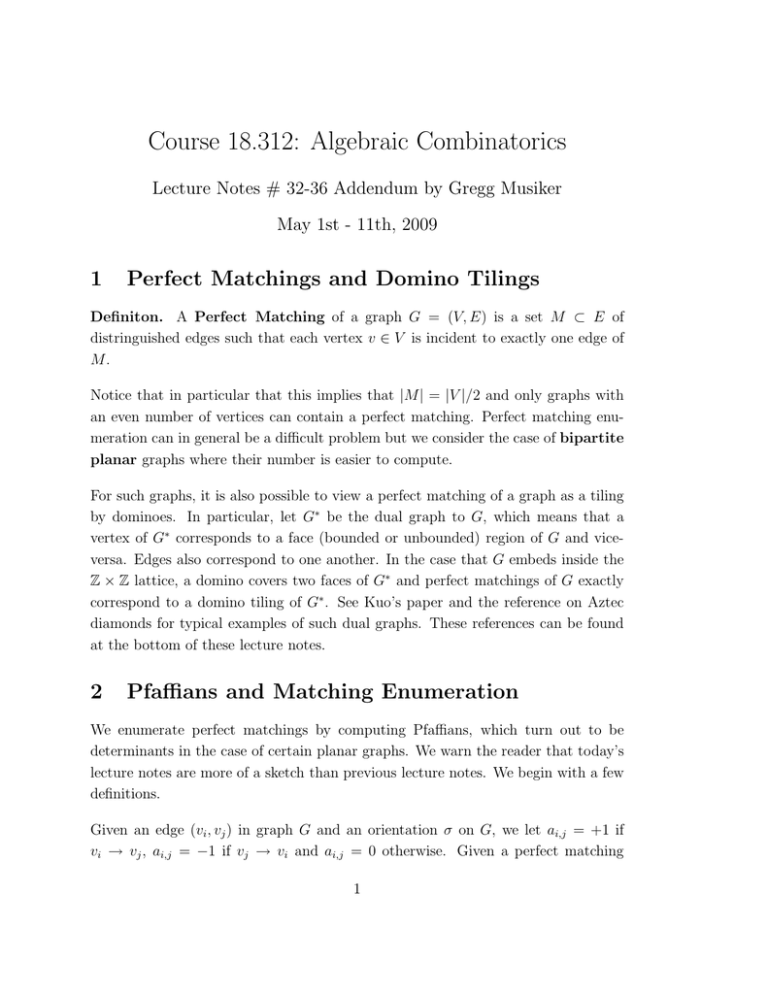
Course 18.312: Algebraic Combinatorics
Lecture Notes # 32-36 Addendum by Gregg Musiker
May 1st - 11th, 2009
1
Perfect Matchings and Domino Tilings
Definiton. A Perfect Matching of a graph G = (V, E) is a set M ⊂ E of
distringuished edges such that each vertex v ∈ V is incident to exactly one edge of
M.
Notice that in particular that this implies that |M | = |V |/2 and only graphs with
an even number of vertices can contain a perfect matching. Perfect matching enu­
meration can in general be a difficult problem but we consider the case of bipartite
planar graphs where their number is easier to compute.
For such graphs, it is also possible to view a perfect matching of a graph as a tiling
by dominoes. In particular, let G∗ be the dual graph to G, which means that a
vertex of G∗ corresponds to a face (bounded or unbounded) region of G and viceversa. Edges also correspond to one another. In the case that G embeds inside the
Z × Z lattice, a domino covers two faces of G∗ and perfect matchings of G exactly
correspond to a domino tiling of G∗ . See Kuo’s paper and the reference on Aztec
diamonds for typical examples of such dual graphs. These references can be found
at the bottom of these lecture notes.
2
Pfaffians and Matching Enumeration
We enumerate perfect matchings by computing Pfaffians, which turn out to be
determinants in the case of certain planar graphs. We warn the reader that today’s
lecture notes are more of a sketch than previous lecture notes. We begin with a few
definitions.
Given an edge (vi , vj ) in graph G and an orientation σ on G, we let ai,j = +1 if
vi → vj , ai,j = −1 if vj → vi and ai,j = 0 otherwise. Given a perfect matching
1
M = {(i1 , j1 ), . . . , (in/2 , jn/2 )} (where ir < jr by convention), we let the sign of the
matching be
sgn(M) = (−1)# crossings in the nesting pattern of M
where we draw 1, 2 through n in a line, and the nesting pattern connects ir and jr
for each edge of M.
Definition. An orientation σ is a Pfaffian orientation�of G if and�only if for all
�n/2
perfect matchings M of G, we have that each expression
sgn (M) has
r=1 air ,jr
the same sign, regardless of the choice of M.
Theorem. Let G be a planar simple finite graph with no bridges (i.e. no edges
whose removal would disconnect the set of vertices of G). Let σ be an orientation
such that the number of clockwise edges about any bounded face is odd. Then σ is
Pfaffian.
To sketch the proof of this Theorem, we will use a sign-preserving map between
pairs of matchings of the line {1, 2, . . . , n} and permutations of Sn :
φ : (M1 , M2 ) −→ σ
such that sgn(M1 )aM1 · sgn(M2 )aM2 = sgn(σ)aσ , where σ denotes the match­
ing {1, σ(1)}, {2, σ(2)}, . . . , {n, σ(n)}. Recall that the sign of a permutation is
(−1)# cycles of even length .
In particular, we draw the line from 1 to n and then connect vertices on the top
according to matching M1 and connect vertices on the bottom using matching M2 .
We then make cycles starting with the smallest element.
Example. Let M1 = {1, 2}, {3, 6}, {4, 5}, M2 = {1, 4}, {2, 5}, {3, 6}. These are
both matchings of the 2-by-3 grid graph with vertices 1, 2, 3 on top and 4, 5, 6 in the
second row. The corresponding permutation is σ = (1254)(36).
Claim. Any σ constructed in this way only has cycles of even length.
In fact, we obtain a bijection since the process is reversible by alternating assign­
ments of edges in the cycles to M1 and M2 . For example, for the permutation
σ = (1, 3)(2, 6, 5, 8)(4, 10, 9, 7), we obtain
M1 = {1, 3}, {2, 6}, {5, 8}, {4, 10}, {9, 7} and M2 = {3, 1}, {6, 5}, {8, 2}, {10, 9}, {7, 4}.
Furthermore, we can pull apart cycles by eliminating two crossings. This is equiva­
lent to rearranging numbers on the line so that if i, j are in different cycles, then their
placements do not affect the sign. The sign is only affected by the ordering within
individual cycles, and a self-crossing can be eliminating by applying a transposition.
Getting back to the main proof, if we assume that an orientation of G is not Pfaf­
fian, then there exists a pair of matchings (M1 , M2 ) so that the signs of M1 and M2
differ:
sgn(M1 )aM1 =
6 sgn(M2 )aM2 which would imply by the theorem that aσ sgn(σ) =
6 +1.
Thus it suffices to show that this sign is −1 instead.
Given an orientation with an odd number of clockwise edges around each bounded
face, we build a permutation σ corresponding to a pair of matchings M1 and M2 .
Then σ breaks into a product of cycles, each of which must have even length. It fol­
lows that sgn(σ) = (−1)# cycles of even length which decomposes as σ = σ1 · · · σt . How­
ever, cycles of σ decmposes V into edges and even cycles (cycles not nec. contained
on a single face) so aσi = # edges oriented clockwise on face induced by cycle σi .
So if each face has an odd number of clockise edges, then we have the result.
Lemma. Let G = (V, E, F ) be a simple connected planar graph without bridges
with an odd number of clockwise edges on each face. Let C be a directed cycle.
Then the number of edges oriented clockwise in C has the opposite parity as the
number of vertices in the interior of C.
Proof omitted, but follows by application of Euler’s formula applied to the subgraph
of G consisting of the interior of C together with cycle C.
Thus we have shown the Theorem that an orientation of G with each face having
an odd number of clockwise edges is Pfaffian. We will not show it in these notes,
but it is possible by induction to show that such an orientation exists.
Main Theorem. If σ is a Pfaffian orientation (which we know exists in certain cases
and we can inductively construct such an orientation) then we have the formula
det A(G) = (# perfect matchings of G)2 ,
�
where det A(G) = σ∈Sn sgn(σ)aσ . The matrix A(G) is the signed adjacency matrix
for the oriented graph.
Application. Consider the m-by-n grid graph Lm,n with m rows and n columns, for
m · n vertices in all. We give this graph an orientation so that all vertical edges are
oriented downwards, the horizontal of the odd (i.e. first, third, etc.) labeled rows
are oriented rightwards, while the even labeled rows are oriented leftwards. Let B
be the n-by-n matrix with a superdiagonal of +1’s, a subdiagonal of −1’s and zeros
everywhere else. The signed adjancency matrix for Lm,n is the (mn)-by-(mn) block
matrix obtained by taking an m-by-m matrix whose superdiagonal are the n-by-n
identity matrices In , subdiagonal entries are −In and diagonal entries are the B’s
defined above. Then all other entries are zero.
By the Theorem, M(Lm,n ), the number of perfect matchings in Lm,n is
√
det A.
Corollary. For n even,
⌊m/2⌋ n/2
M(Lm,n ) = 4
⌊m/2⌋
�
� � �
kπ
ℓπ
2
2
cos (
n/2
) + cos (
) .
m
+
1
n
+
1
k=1 ℓ=1
Other applications of Pffafians provide formulas for Aztec Diamonds and vari­
ants.
3
References for Height functions, Domino Tilings,
and Aztec Diamonds
“Alternating sign matrices and domino tilings” by Noam Elkies, Greg Kuperberg,
Michael Larsen, and James Propp
http://arxiv.org/pdf/math/9201305v1
and “Applications of graphical condensation for enumerating matchings and
tilings” by Eric Kuo
http://arxiv.org/pdf/math.CO/0304090.pdf
MIT OpenCourseWare
http://ocw.mit.edu
18.312 Algebraic Combinatorics
Spring 2009
For information about citing these materials or our Terms of Use, visit: http://ocw.mit.edu/terms.



